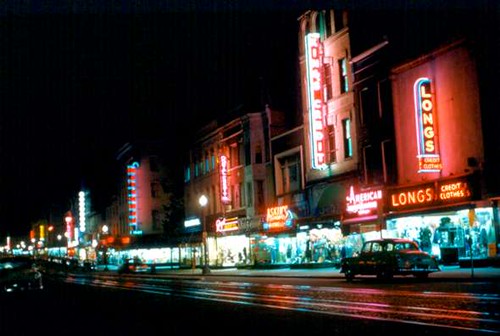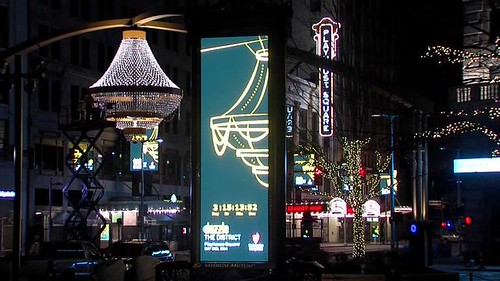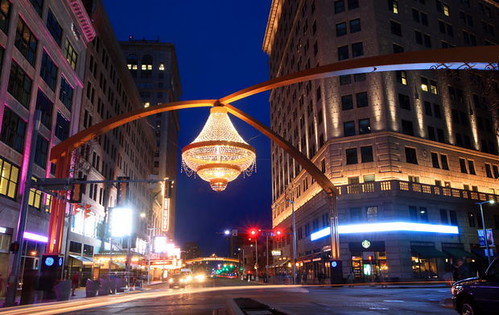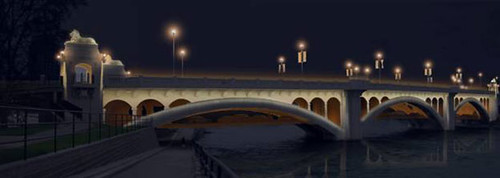Lighting as an element of urban design and community identity: Cleveland chandelier + Chicago lighting design framework plan design competition
I have been enamored of architectural lighting and neon and electric signs as an element of the built environment for quite some time. But I hadn't considered the issue as systematically as I should have, for example along the lines of the six elements identified in the Eindhoven Lighting Master Plan discussed below.
The six categories of light:
- urban lighting (streets, public areas)
- buildings and objects
- art (indoor and outdoor)
- events and festivals
- information
- advertising.
 F Street in Downtown Washington, DC in the 1950s. Image from Reston Paths.
F Street in Downtown Washington, DC in the 1950s. Image from Reston Paths.In the days of thriving center city commercial districts and neighborhood theaters, electric and neon signs were distinctive elements of the visual identity of these districts.
And even when the stores were closed at night, attractive signs denoting the businesses and their wares were typically lighted.
Some interesting architectural lighting programs and events I've come across over the years include the program in Cleveland to light church steeples (Steeple Lighting Program, Cleveland Restoration Society), various lumiere festivals--mostly in Europe (e.g. Lux Helsinki), and light art and temporary lighting installations.
Of course, Times Square in New York City, NYC's Broadway Theatre District and the lighted marquees, "The Strip" in Las Vegas, and the entryway to Reno's casino district are prominent examples of places that continue to define themselves through "out of this world" lighted signage.
Image from NYC Loves NYC blog.
On Broadway, the McDonald's Restaurant has incorporated a lighted marquee into the facade as an element of its store design, to leverage and connect to the area's cultural and architectural heritage.
New chandelier in Cleveland's Playhouse Square. Playhouse Square is a national best practice example of arts, in this case, theater, based revitalization. Playhouse Square had four large theaters that by the 1960s, had largely been abandoned in response to suburbanization.
An architect assigned to figure out what to do realized that the theaters could be combined into an integrated operation by creating a common entry-foyer system. Since then the Playhouse Square Foundation has been organized as a community development corporation and has been spearheading the revitalization of that area (see the past blog entry, "The Howard and Lincoln Theatres: run them like the Pittsburgh Cultural Trust/Playhouse Square Cleveland model").

Image from Channel 5, Cleveland shows the various elements of the lighting project, which are not limited to the new chandelier.

Image: Joshua Gunter, Cleveland Plain Dealer.
The latest element introduced to the Playhouse Square district by the Foundation is a chandelier, the world's largest outdoor chandelier, placed at "the center of Playhouse Square" at 14th Street and Euclid Avenue. It was lit in an opening ceremony on May 2nd, an event which attracted over 20,000 people, place at the intersection of , as a way to further define the visual elements of the area, by playing off how the old grand theaters typically had chandeliers as the centerpiece of their foyers. See "Playhouse Square's chandelier succeeds as an instant icon for Cleveland's theater district" from the Cleveland Plain Dealer.
-- Video from PlayhouseSquare Foundation about the "Dazzle the District" project
While some criticize the chandelier as kitschy and popular, by all reports it is popular with residents and visitors and is becoming a signature landmark and a place to meet and be seen. From the article:
... the 20-foot-tall outdoor chandelier – officially declared by Guinness last week as the largest in the world - is already helping to create the visible vitality that Playhouse Square has long sought and never quite achieved.
Even though the theater district has attracted a million visitors a year to its revitalized 1920s movie palaces and Vaudeville houses, the liveliness has never seemed to reach out to Euclid Avenue, the city’s once and future Main Street.The chandelier is part of a broader set of streetscape improvements and identity elements, including gateway arches, kiosk signage, etc.
Chicago lighting design/plan competition. The City of Chicago takes the Playhouse Square initiative a couple steps further, by proposing ("A bright idea: City aims to light up architecture to boost tourism," Chicago Sun-Times) to enhance and use distinctive architectural lighting as an element of the city's identity..
 To illustrate and develop the lighting-identity concept (rendering of a concept for the Chicago River, left), Chicago has announced a design competition ("Emanuel launches design contest to make Chicago 'city of lights'," CST)
To illustrate and develop the lighting-identity concept (rendering of a concept for the Chicago River, left), Chicago has announced a design competition ("Emanuel launches design contest to make Chicago 'city of lights'," CST)to spotlight five Chicago signatures: the Chicago River, iconic buildings, 180 bridges, a CTA L system that’s one of the most “physically striking” in the world and Lower Wacker Driveas a step towards the creation of a lighting framework master plan.
-- RFP for Chicago's lighting design competition, due July 7th
 Lighting master plans. A handful of cities have moved beyond light festivals and have created lighting master plans to address night time lighting, architectural lighting, and events, as well as energy savings and other issues. From the article:
Lighting master plans. A handful of cities have moved beyond light festivals and have created lighting master plans to address night time lighting, architectural lighting, and events, as well as energy savings and other issues. From the article:This holistic approach to illuminating cities has come to be known as a lighting master plan. While few cities outside Europe have a plan currently in place, the steps involved in creating one help officials evaluate how the layers of lighting – street-level, marquees and directional signage, and monuments or cultural landmarks – should work together and be energy efficient.Eindhoven, Netherlands is probably the furthest along of any city in terms of lighting planning, partly because the city is the headquarters of Philips Corporation, which has had lighting as one of its core business lines since the company's founding more than 100 years ago. From "Master Plan | Eindhoven, the Netherlands: An integrated approach to urban lighting melds Eindhoven's past, present, and future":
While light has been a part of Eindhoven's history since the founding of Philips in the late 19th century, only recently has urban lighting gained such a prominent role in the visual identity and experience of the city. In 2004, the city council asked van Stiphout to rewrite the existing lighting master plan, then 9 years old. The highly technical (and outdated) document, according to van Stiphout, “only focused on the public lighting of the city.”-- Light-S, lighting design innovation program, Eindhoven
In discussions with then-mayor Alexander Sakkers (who served 2003–07), it was decided a new approach for Eindhoven was needed to address (and market) the unique identity of the city. In particular, Sakkers wanted to call attention to the importance of having a company like Philips in Eindhoven and to the role of the city as a “Brainport”—leading to a brand campaign to promote the region's leadership in technology and research. Van Stiphout, realizing that it no longer was appropriate to just “rewrite” the existing master plan, composed “a future vision for Eindhoven, with respect to light, and how we can be different from other cities in the Netherlands, Europe, and even the world.”
The project began with analysis of all aspects of lighting in the city to define a set of goals for the next decade. With this research, van Stiphout identified six categories of light: urban lighting (streets, public areas), buildings and objects, art (indoor and outdoor), events and festivals, information, and advertising.
In North America, San Diego (Downtown Lighting Master Plan) and the Quartier des spectacles in Montreal ("Axel Morgenthaler on the Quartier des spectacles," Spacing Magazine).
While Calgary doesn't have a full-blown lighting master plan, they have created the Centre City Illumination Guidelines as an element of the city's urban design and revitalization program for their downtown. They are using an architectural lighting project for the Centre Street Bridge (below) as a way to illustrate these principles.

Festivals. Lyon, France has had a lighting festival, Festival des Lumières, since the 1850s. According to the Christian Science Monitor article "Cities shed artful light on the canvas of night,"
building facades become moveable feasts of color and familiar landmarks take on an animated aspect. Street performances and music round out the celebration, and people are seen strolling and admiring the magically transformed cityscape.Night time lighting and safety. Earlier in the year I wrote a couple of pieces on this ("Night-time safety: rethinking lighting in the context of a walking community"), advocating for structured programs for addressing night time lighting issues in "the walking city."
Association. There is an association, LUCI | Lighting Urban Community International, linking those cities addressing lighting as an identity element.
Signage. Many cities have programs to assist businesses with the development of high quality storefront signage, which can be a distinctive element of business, commercial district, and community identity.
-- Thrive: Guide to Storefront Design in the District of Columbia, DC Office of Planning
Typically, the focus isn't on electric or neon signs, which cost a lot more to construct and there are few craftspeople with the skills to do so.
Image: Inside the American Sign Museum. City museums in Richmond and Pittsburgh also display electric and neon signs from defunct but memorable businesses that once operated in their respective cities.
However, the program didn't promote the development of neon and electric signage specifically, and it occurred to me that they could extend the sign program city-wide, but focused on neon and electric signage exclusively, as a way to promote the museum and better tie it into other cultural and tourism promotion objectives.
-- Museum of Neon Art, Los Angeles
-- Exhibition at the AIA/Philadelphia
Night lighting as light pollution. Separately there are initiatives to reduce lighting at night, because of the impact on the environment ("Light pollution," National Geographic Magazine). Those issues have also been raised in the context of the Chicago initiative ("Environmental group takes dim view of Emanuel’s night light plan," CST).
-- International Dark-Sky Association
A Helsinki tram is specially lighted as part of the Lux Helsinki Festival. Wikipedia photo.
Labels: architectural lighting, branding-identity, tourism, urban design/placemaking, urban revitalization







3 Comments:
"Conceiving monument networks through lighting design, Academia Letters, 2021
https://www.academia.edu/67134604/Conceiving_monument_networks_through_lighting_design
Urban lighting plays an important role in shaping the image and experience of a city, as it allows for the redenition of its function during the night. Usually, historic city centres focus on ephemeral marketing strategies to attract tourists, or the highlighting of solitary monuments, an approach which has resulted in the complete absence of a monument network.
In the context of this paper, there has been an attempt to detect and codify navigational concepts in nocturnal urban environments and dene various wayfinding elements on various case studies. Such a process will oer the opportunity to locals and visitors to delve into a slice of a city’s history and identity with positive emotional connotations (Whitlock, Skandali,2020).
The paper culminates in a lighting proposal for the historic city center of Thessaloniki that aims to create a monument network generated through lighting. The monuments included in the proposed network were organised according to their chronological period, their architectural features and most importantly by their positioning within the urban plan.
======
I wrote this piece on Thessaloniki for the Europe in Baltimore series sponsored by the EU National Institutes of Culture Washington Chapter in 2014
https://web.archive.org/web/20171027203723/http://europeinbaltimore.org/thessaloniki-regeneration-as-an-ongoing-process/
Lighting signs for business play an indispensable role in drawing attention and enhancing brand visibility. Their luminous presence acts as a silent yet powerful marketing tool, ensuring businesses stand out amidst competition. Whether it's neon, LED, or other innovative lighting solutions, these signs illuminate storefronts, conveying messages effectively. Thanks for spotlighting the significance of lighting signs for business—they serve as beacons guiding customers and contributing significantly to the overall ambiance, leaving a lasting impression that resonates with potential clientele. Here find more information on lighting signs for business.
I can’t speak highly enough of the Architects in Noida I worked with! They delivered an outstanding design that perfectly matched my style and needs. Their attention to detail and seamless execution made the process enjoyable. I’m thrilled with the results and would recommend these architects in Noida to anyone looking for high-quality work!
Post a Comment
<< Home